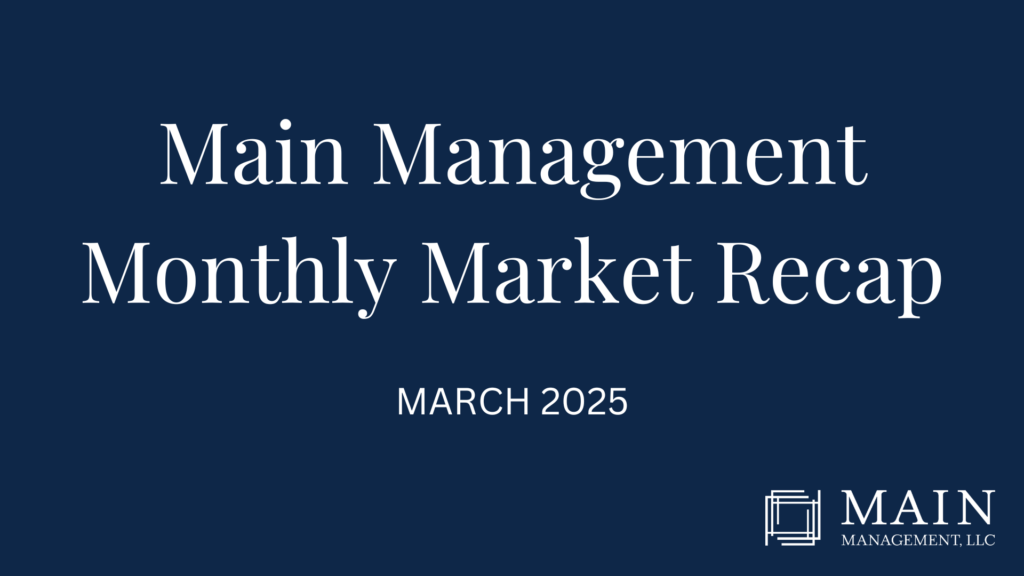Happy April! (and hopefully happier for markets than March).
March finished with the S&P 500 down -5.75%, the worst month since Dec 2022 (-5.90%), and well its historical median & average returns.
During the month, the S&P 500 officially entered correction territory as it was down more than 10% from its Feb 19 high…

In the wake of March’s poor performance, we took a look at April and the next 3mo returns for years when March was down more than -3% since 1945.
Going forward, the returns are far more positive than negative.

The month was marked by uncertainty, as exhibited by the US Economic Policy Uncertainty Index surging to 447, one of the highest readings on record behind only covid’s peak.
Forward S&P 500 returns from peaks tend to be higher than normal…

As a result of said uncertainty, the S&P 500 entered correction territory briefly on March 13 from its peak on Feb 19, a quicker decline than usual…

We’ve now closed out the 1st quarter of 2025 down -4.59% (Jan: +2.70%, Feb: -1.42%, Mar: -5.75%).

Here are historical Q1 returns back to 1928 (median is +2.1%)…

Looking ahead to April, it’s been up 62 out of 97 times (64% batting average).
When it’s up, it’s up +4.31% on average and when it’s down, it’s down -3.98% on average.

Election year path – peak was on Feb 19, down just over -10% to the trough on March 13.

Sector performance YTD – Energy and Healthcare leaders with Info Tech and Cons Discret laggards…

For March, Energy was the only positive sector up +2.7% while Cons Discret and Info Tech were the laggards, down -8.6% and -8.4%, respectively.

And in case you’d forgotten about diversification with the concentrated Mag-7 performance in 2023-2024, it’s back this year with the ACWX up +6.3% YTD, more than 10% ahead of the S&P 500, and bonds up +2.1%, also solidly ahead.

Other performance derby bar charts…

Yields were mostly unchanged to slightly lower during March… but High Yield bucked the trend, rising to end the month.

On the Treasury side, 10yr yields were a bit more stable than 2yr yields (which declined). 3mo and Fed Funds basically unch in March.

Volatility indices rose and fell during March with the headline VIX entering the month at 22.8, getting up to 27.9 (close), and then retreating to 22.3.

The FOMC met during the week of March 17 and elected to keep the Fed Funds Rate unchanged, as expected.
They continue to forecast 2 rate cuts this year, in line with market forecasts.
The 2025 revisions reveal a slightly weaker view of the economy than the committee had in December but are still not indicative of an economy heading into a recession.
The Summary of Economic Projections showed a downward revision to the 2025 GDP forecast, from 2.1% at December’s meeting to 1.7% this week.
The Unemployment Rate is now expected to be 4.4% vs 4.3% in December and Core PCE Inflation is now expected to be 2.8% vs 2.5%.
The 2026 Core PCE Inflation forecast was unchanged at 2.2%.
The Fed also announced it will slow the pace at which it is reducing its balance sheet, aka “Quantitative Tightening,” due to concerns around the debt limit.

Sentiment soured (further) in March as the S&P 500 briefly entered correction territory in quick fashion.
AAII investor sentiment bears remain elevated and bulls are low – forward returns have historically been more positive from these levels vs all periods.

NFIB Small Business Optimism has retraced its post-election gains, declining to 100.7.

UMich Consumer Sentiment and Conference Board sentiment are both down markedly of late as uncertainty and inflation fears are weighing on consumers.

CNN Fear & Greed came into the month at 20 and left at 22…

NAAIM positioning has become less bullish of late, tumbling to 57.6 average exposure to US equity markets, the lowest since Aug 2024.

As sentiment has declined, inflation expectations have jumped.
Both the UMich and Conference Board 1yr inflation expectations have surged to around 5%!
NY Fed responses have not followed suit with its 1yr figure still at 3.1%.

After dropping to -16.5 earlier this year, the Citi US Economic Surprise Index is nearly back to 0, implying that data surprises are less negative…

While sentiment is clearly pessimistic, the macro data has largely held up and February saw CPI and PPI come in below forecasts while PCE was hotter than expected.
Core PCE rose +0.37% m/m in February, above forecasts for a 0.3% rise, and the y/y figure inched up to +2.79%. that’s the fastest m/m increase since Jan 2024.

February consumer spending was weaker than expected at +0.43% m/m, slowing to +5.29% y/y.

Incomes surged though, up +0.77% m/m, fastest since Jan 2024, and are up +4.56% y/y. incomes continue to outpace inflation which is good for consumers.

Headline CPI up +0.22% m/m, below forecasts, and slowed to +2.81% y/y.

Core CPI also came in below forecasts at +0.23% m/m and slowing to +3.14% y/y, smallest rise since April 2021!

Broad and Core PPI also came in below forecasts, actually declining on a m/m basis with Broad down -0.01% and Core down -0.05%.

The y/y figures decelerated as well, with Broad slowing to +3.15% and Core slowing to +3.44%.
PPI tends to lead CPI, so this is a positive (at least from a historical perspective) lead for next month’s CPI.

In other macro news, Nonfarm payrolls came in at 151k back at the start of the month, a bit light vs the 170k forecasted figure.
Interestingly, given the changing immigration figure, Goldman Sachs forecasts that the replacement rate could fall from 130k currently to just 80k by the end of this year.

Earnings were up +0.28% m/m and accelerated to +4.02%, still outpacing inflation.

Headline U3 Employment rate ticked up to 4.1% while the broader U6 rate jumped to 8.0%, the highest since Oct 2021.

The higher frequency claims data hasn’t moved much… also a sign of a stable labor market.


The final reading for Q4 2024 US GDP was revised up to 2.45% from the 2nd estimate at 2.35%.
Recent estimates for Q1 2025 forecasts have been revised lower (0-1%), but that’s primarily due to trade balance figures and not consumer spending, which is 70% of the economy.

Q4 consumer spending was revised slightly lower to 4% from 4.2%, but that’s still the best since Q1 2023.
Final Sales also posted a solid +3.32%. biggest revisions were in imports and exports which, as mentioned above, are weighing on the Q1 figure as well.

The 2nd estimate for Q4 Productivity was revised up to 1.5% from 1.2%.

And Unit Labor Costs were revised solidly down to 2.2% from 3.0%, also playing into the disinflation trend…

Industrial Production up +0.75% m/m in February, solidly ahead of forecasts for a 0.2% rise and the 3rd straight monthly gain.
y/y slowed slightly to +1.44% due to the strong Feb 2024 comp of +1.23%.

On the housing front, Existing Home Sales ticked up to 4.260mil units, down -1.2% y/y. Still being weighed on by high mortgage rates…

Starts accelerated unexpectedly in February, Total Starts now stand at 1.50mil SAAR vs forecasts for 1.38mil, Single Family at 1.11mil (most since Feb 2024) and Multi at 370k.

Total Durable Goods Orders surprised to the upside while Core Capital Goods, which are a business spending proxy, declined unexpectedly.

Oil prices have been trending higher – troughed early in March and are up around 5-5.5% since then… (still down more than 10% y/y).

Gas prices jumped +$0.06 w/w to end the month and ticked up to $3.24/gal – still pretty low relative to recent years.

Jet fuel posted consistent daily gains to end the month as well, rising to $2.09/gal






